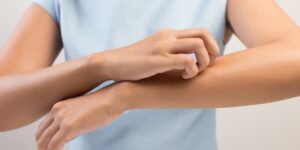Managing Eczema
Eczema is a common term for atopic dermatitis, a skin condition characterized by inflamed skin with itching, dryness, and irritation. It typically begins to appear in childhood and in many cases will self-correct during adolescence.
In fact, roughly 50% of people with eczema begin to develop symptoms within the first year of life, with 95% of people with eczema reporting symptoms by five years of age. Roughly 75% of people with childhood onset of the disease spontaneously improve before adolescence, while the remaining 25% either continue to have eczema into adulthood or experience a relapse of symptoms after symptom-free years. Historically, eczema became more common around the world as infectious disease decreased. Rates don’t increase indefinitely, however. In some of the world’s most developed nations, prevalence rates plateaued at about 20%.
What are the Symptoms of Eczema?
Dry, scaly skin is usually the first symptom. It begins to appear (typically in the first year of life), primarily on the scalp, forehead, and cheeks, as well as in the creases of the elbows and knees. A rash is often present, which may be weepy or ooze fluid. It may also be itchy. Scratching, however, increases the risk of infection.
Who is At Risk for Eczema?
Those most likely to experience eczema include individuals who:
- have a family history of eczema or hay fever
- are living in a developed country and/or a large city
- are female
- enjoy higher socioeconomic status
What Triggers an Eczema Flareup?
- cosmetic irritants such as soaps and detergents
- environmental factors or allergens such as dander, dust, or mold.
- food allergies (peanuts, cow’s milk, eggs, gluten)
- clothing, especially synthetic fabrics (or detergent from clothing)
- hormonal changes (pregnancy or monthly changes)
- topical infections
How Can I Prevent Eczema?
The best way to prevent eczema is to focus on lifestyle factors early in the lifespan. The microbiome of both the gut and the skin appear to be closely related to the onset of eczema. Children who were breastfed for at least 4 months are less likely to develop eczema. Additionally, children who take probiotics during the first 2 years of life also appear to be less likely to develop eczema.
What Natural Solutions Help with Eczema?
CHAMOMILE
In 2000, a standardized chamomile cream (Kamillosan™) was tested against two comparisons: a 0.5% hydrocortisone cream and a placebo. The study evaluated effects over 2 weeks. The cream being tested was a 10.5% chamomile water-based ointment with lanolin. In this study, the cream was found to be superior to both the placebo and the standard hydrocortisone ointment, without the side effects.
CALENDULA
Calendula is used in many cases of dermatitis for relief of inflammation and soothing of the itching and irritation. There are multiple studies that demonstrate its efficacy in a topical application of a 5-15% cream.
LICORICE
Licorice can be used topically in gels or creams for eczema and other types of dermatitis. It doesn’t take a lot of licorice to produce effects; most creams use between 1 and 3%. In a 2003 study, it was found that a 2% licorice cream is more effective than 1%, with benefits that were evident in only 2 weeks.
REFERENCES
DaVeiga, S. P. (2012, May). Epidemiology of atopic dermatitis: a review. In Allergy and Asthma Proceedings 33(3):227-234.
Fiocchi, A., Pawankar, R., Cuello-Garcia, C., Ahn, K., Al-Hammadi, S., Agarwal, A., … & Gandhi, S. (2015). World Allergy Organization-McMaster university guidelines for allergic disease prevention (GLAD-P): probiotics. World Allergy Organization Journal, 8(1), 1.
Hanifin JM, Reed ML. A population-based survey of eczema prevalence in the United States. Dermatitis. 2007 Jun;18(2):82-91.
Nutten, S. (2015). Atopic dermatitis: global epidemiology and risk factors. Annals of Nutrition and Metabolism, 66(Suppl. 1), 8-16.
Patzelt-Wenczler, R., & Ponce-Pöschl, E. (2000). Proof of efficacy of Kamillosan (R) cream in atopic eczema. European journal of medical research, 5(4), 171-175.
Saeedi M, Morteza-Semnani K, & Ghoreishi MR. (2003). The treatment of atopic dermatitis with licorice gel. Journal of Dermatological Treatment. 14(3):153-7.

